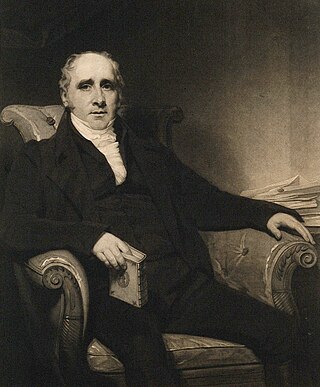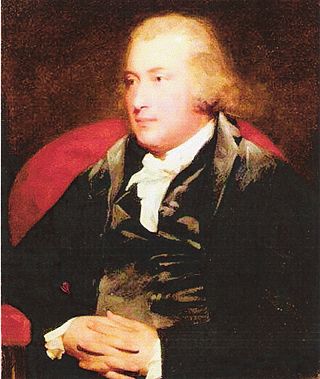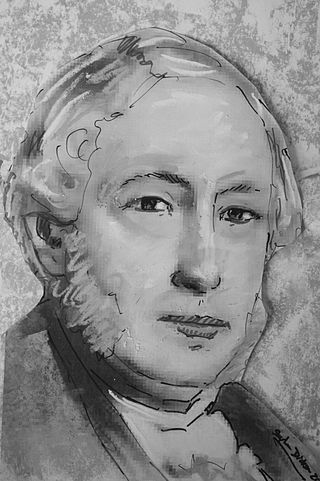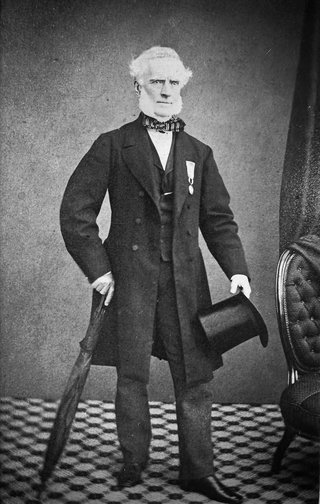Related Research Articles

Thomas Charles Hope was a Scottish physician, chemist and lecturer. He proved the existence of the element strontium, and gave his name to Hope's Experiment, which shows that water reaches its maximum density at 4 °C (39 °F).

Colin Lauder, Worlds End Close, Edinburgh) was a fellow of the Royal College of Surgeons of Edinburgh FRCSEd, and a burgess of Edinburgh. His portrait was painted by Sir Henry Raeburn.

Robert Graham was a Scottish physician and botanist.

James Begbie was a Scottish medical doctor who served as president of the Medico-Chirurgical Society of Edinburgh (1850–2) and as president of the Royal College of Physicians of Edinburgh (1854–6).

Sir Andrew Douglas MaclaganPRSE FRCPE FRCSE FCS FRSSA was a Scottish surgeon, toxicologist and scholar of medical jurisprudence. He served as president of 5 learned societies: the Royal Medical Society (1832), the Royal College of Surgeons of Edinburgh (1859–61), the Royal College of Physicians of Edinburgh (1884–87), the Royal Society of Edinburgh (1890–5), and the Royal Scottish Society of Arts (1900).
Thomas Jones Mackie CBE FRSE LLD was a noted Scottish bacteriologist; Dean of the Faculty of Medicine, University of Edinburgh; and author of medical research textbooks.

Andrew Duncan, the elder FRSE FRCPE FSA (Scot) was a British physician and professor at the University of Edinburgh. He was joint founder of the Royal Society of Edinburgh. As first proposer of an asylum in Edinburgh he gives his name to the Andrew Duncan Clinic which forms part of the Edinburgh City Hospital.
Professor Andrew Fyfe FRSE FRCSE PRSSA PRMS was a Scottish surgeon and chemist. Following early studies on Fox Talbot's newly created photographic techniques he was one of the first (1839) to work out the theory behind positive rather than negative prints. He had an amateur interest in photography but appears not to have pursued his own theories and limited his experiments to ferns lying on chemical papers.

John Gray McKendrick FRS FRSE FRCPE LLD was a distinguished Scottish physiologist. He was born and studied in Aberdeen, Scotland, and served as Regius Professor of Physiology at the University of Glasgow from 1876 to 1906. He was co-founder of the Physiological Society.

William Saunders FRS FRSE was a Scottish physician who was the first president of the Royal Medical and Chirurgical Society.

James Miller FRCSEd, FRSE was a surgeon and medical author in Edinburgh. He was author of the important 19th century textbook, Principles of Surgery. Like his father he became a member of the Free Church of Scotland in 1843 and was a firm believer in temperance.

James Russell FRSE RSA (1754–1836) was a Scottish surgeon who was the first professor of clinical surgery at the University of Edinburgh. He was president of the Royal College of Surgeons of Edinburgh and was a co-founder of the Royal Society of Edinburgh. In 1805 he published one of the earliest descriptions of direct inguinal hernia. His collection of anatomical specimens was donated to the Surgeon's Hall in Edinburgh and is now known as the James Russell Collection.
Dr William Craig FRSE FRCSE was a Scottish surgeon and botanist. He was an expert on jaborandi, an appetite suppressant. His collections and studies were largely focussed upon Perthshire in central Scotland.

Robert James Blair Cunynghame of Cronan, FRCSEd, FRSE JP was a prominent Scottish surgeon, physiologist and early forensic scientist in the late 19th century. He served as President of the Royal College of Surgeons of Edinburgh from 1891 to 1893. He is said to have had a calm, beautiful face and his opinion was used as a benchmark to medical thought.

Peter David Handyside FRSE FRCSE (1808–1881) was a Scottish surgeon and anatomist. He was president of the Royal Medical Society in 1828. He won the Harveian Society Medal in 1827. He was also president of the Medico-Chirurgical Society of Edinburgh in 1871.

James Holmes Hutchison was a Scottish paediatrician and Samson Gemmell Professor of Child Heath at Glasgow University from 1961 to 1977. From 1977 onwards he was Professor of Child Health at the University of Hong Kong. Friends knew him as Jim Hutchison.

Sir William Newbigging FRSE FRCSEd FRGS was a Scottish surgeon who served as President of the Royal College of Surgeons of Edinburgh from 1814 to 1816. He was a keen amateur geographer.

Dr John MacWhirter FRSE PRCPE (1783–1854) was a 19th-century Scottish physician who served as president of the Royal College of Physicians of Edinburgh from 1831 to 1833.

Samuel Alexander Pagan MD FRSE FRCSEd (1793–1867) was a 19th-century Scottish surgeon and obstetrician. He served as President of the Royal College of Surgeons of Edinburgh from 1846 to 1848 and President of the Harveian Society in 1849.
George Smith (1919–1994) was a 20th century Scottish surgeon who emigrated to the United States of America.
References
- ↑ Scots Magazine, June 1776, p.339
- ↑ William Innes Addison (1898). A Roll of the Graduates of the University of Glasgow from 31st December 1727 to 31st December 1897, with short biographical notes. Glasgow, MacLehose. p. 685.
- ↑ "Inspiring Physicians - RCP".
- ↑ Watson Wemyss, Herbert Lindesay (1933). A Record of the Edinburgh Harveian Society. T&A Constable, Edinburgh.
- ↑ Minute Books of the Harveian Society. Library of the Royal College of Physicians of Edinburgh.
- ↑ Biographical Index of Former Fellows of the Royal Society of Edinburgh 1783–2002 (PDF). The Royal Society of Edinburgh. July 2006. ISBN 0-902-198-84-X.
- ↑ Glasgow Post Office Directory 1805
- ↑ Annals of Glasgow, James Cleland